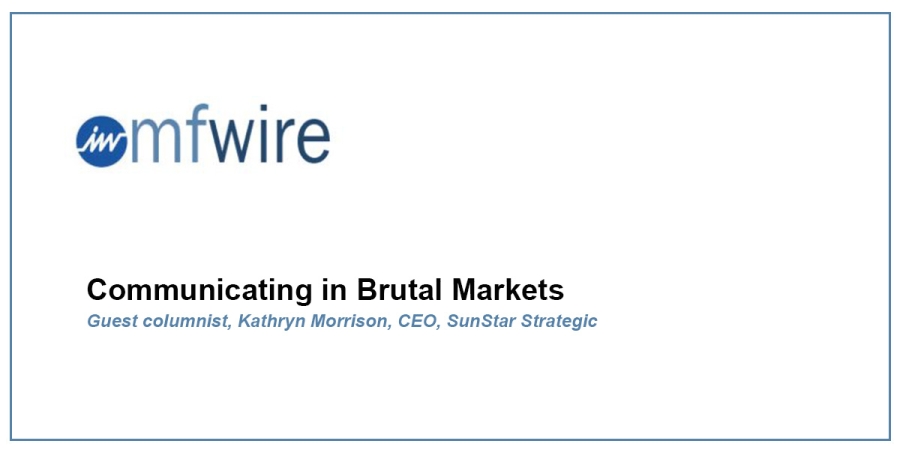Kathryn Morrison, president and CEO of SunStar Strategic, authored an article featured on MF Wire.
Communicating In Brutal Markets
Given the brutal market with its breathtaking plunges, many investors are afraid. Fund managers have a responsibility to communicate with all their shareholders and help advisors explain to clients what's happening and what would be the next right step for them.
Reassurance is a Must
Advisors want help. There's an opportunity for asset managers to remind advisors about the quality of their portfolios, so they in turn can remind their clients why they are invested with those managers, and why those investments remain sound.
Offer Historical Perspective
Volatility is part of the world we live in and is reflected in today's securities markets. Market plunges have happened before and will happen again. Asset managers have the tools to give investors the perspective from a historical standpoint and remind them why market timing is almost impossible.
In March 2009 when the market fell dramatically, many investors panicked, yet in hindsight, that would have been a great time to invest.
Show Confidence in Your Process
Value managers may want to emphasize that fundamentals are what's important, even when the market is not currently valuing them. These managers may be able to illustrate that in rough and falling markets their style has offered less volatility and more protection on the downside than other management styles.
But growth managers also have a story to tell. While a growth management style can have gut wrenching declines, it frequently outperforms other management styles. Growth managers can also remind investors that markets frequently have sharp rallies and they will be able to quickly identify and invest in the new winners.
In either case, it's crucial to remind investors that having money in the market is a long-term proposition, and the time frame that's important is the one that matches their personal objective.
Be Proactive and Quick
In an unpredictable market, managers should simultaneously use a wide array of techniques to reach all their shareholders. The quickest way to make the most information available to the most people is to post it on the website. Frightened investors and their advisors can immediately access it when looking for reassurance. Reporters also check the sites. News coverage may not be immediate but is powerful and reaches a large audience. Emails are quick and effective for advisors, but do not reach retail shareholders. Twitter and Linked-In are instant but have a limited, though important, audience.
When possible, personal calls are the best way to communicate with advisors and clients. Portfolio managers should be more accessible to advisors through a group zoom or a conference call. Managers can make videos to post on the website. Communication directly from the portfolio managers gives advisors more insight and confidence.
Slower, but effective, are letters or position papers that can be sent to every advisor and large shareholder.
Rely on an Infrastructure
It's best to have a communication infrastructure in place before the markets get hit. Having the people, techniques and lists identified in advance means a firm can execute quickly as it develops responses to the specifics of the market situation.
If there is no plan in place, managers will have to work quickly to put their thoughts together. They know the strengths of their process and have an understanding of what's happening. If internal resources are not available to execute, they can look to their outside partners to help provide that information through a variety of communication methods.
The Silver Lining
Turbulent markets offer a unique opportunity for managers to communicate in a meaningful way with advisors and shareholders.
Further, the most heartening thing for managers following a market trauma is hearing from advisors who acknowledge that the asset manager's insights provided the perspective that helped calm their clients and that encouraged them to stay with their previously customized investment plans.
Kathryn Morrison serves as president and CEO of SunStar Strategic.
Read the article on MF Wire


